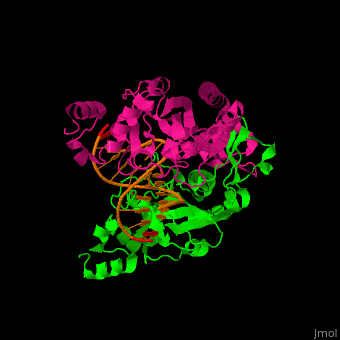Endonuclease
From Proteopedia
(Difference between revisions)
| Line 5: | Line 5: | ||
'''Endonuclease''' (ENN) cleaves phosphodiester bond within polynucleotide chain. ENN cleaves DNA at a restriction site which is usually a 6-nucleotide palindrome. ENN is restriction site–specific. Various types of ENN differ by their mechanism of action. ENN is used in genetic engineering to make recombinant DNA. ENN requires a restriction site and a cleavage pattern. '''ENN-I''' operates on DNA with separate restriction site and cleavage pattern, while '''ENN-II''' operates on overlapping restriction site and cleavage pattern. Some ENNs are encoded within introns thus facilitating their mobility. These ENNs or inteins are designated I-ENN<ref>PMID:12483517</ref>.<br /> | '''Endonuclease''' (ENN) cleaves phosphodiester bond within polynucleotide chain. ENN cleaves DNA at a restriction site which is usually a 6-nucleotide palindrome. ENN is restriction site–specific. Various types of ENN differ by their mechanism of action. ENN is used in genetic engineering to make recombinant DNA. ENN requires a restriction site and a cleavage pattern. '''ENN-I''' operates on DNA with separate restriction site and cleavage pattern, while '''ENN-II''' operates on overlapping restriction site and cleavage pattern. Some ENNs are encoded within introns thus facilitating their mobility. These ENNs or inteins are designated I-ENN<ref>PMID:12483517</ref>.<br /> | ||
The '''Cas ENN''' proteins are part of '''CRISPR/Cas''' prokaryotic immune system which confers protection from foreign genetic elements like viruses. The '''CRISPR''' ('''C'''lustered '''R'''egularly '''I'''nterspersed '''S'''hort '''P'''alindromic '''R'''epeats) are DNA loci which are found in ca. 40% of the bacteria. The CRISPR/Cas system is being used lately as gene editing tool<ref>PMID:20056882</ref>. For more details see<br /> | The '''Cas ENN''' proteins are part of '''CRISPR/Cas''' prokaryotic immune system which confers protection from foreign genetic elements like viruses. The '''CRISPR''' ('''C'''lustered '''R'''egularly '''I'''nterspersed '''S'''hort '''P'''alindromic '''R'''epeats) are DNA loci which are found in ca. 40% of the bacteria. The CRISPR/Cas system is being used lately as gene editing tool<ref>PMID:20056882</ref>. For more details see<br /> | ||
| + | * [[CRISPR-Cas Part I]]<br /> | ||
| + | * [[CRISPR-Cas Part II]]<br /> | ||
* [[Cas9]]<br /> | * [[Cas9]]<br /> | ||
* [[CRISPR-Cas9]]<br /> | * [[CRISPR-Cas9]]<br /> | ||
Revision as of 16:47, 16 January 2017
| |||||||||||
3D structures of endonuclease
Updated on 16-January-2017
References
- ↑ Nishino T, Morikawa K. Structure and function of nucleases in DNA repair: shape, grip and blade of the DNA scissors. Oncogene. 2002 Dec 16;21(58):9022-32. PMID:12483517 doi:http://dx.doi.org/10.1038/sj.onc.1206135
- ↑ Horvath P, Barrangou R. CRISPR/Cas, the immune system of bacteria and archaea. Science. 2010 Jan 8;327(5962):167-70. doi: 10.1126/science.1179555. PMID:20056882 doi:http://dx.doi.org/10.1126/science.1179555
- ↑ Flick KE, Jurica MS, Monnat RJ Jr, Stoddard BL. DNA binding and cleavage by the nuclear intron-encoded homing endonuclease I-PpoI. Nature. 1998 Jul 2;394(6688):96-101. PMID:9665136 doi:10.1038/27952

